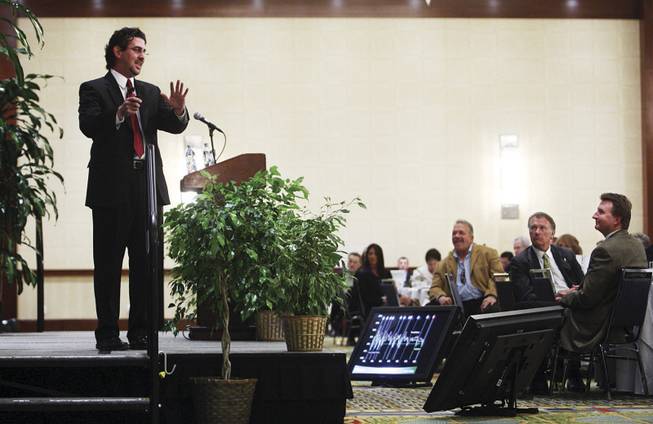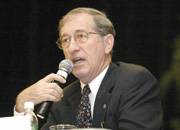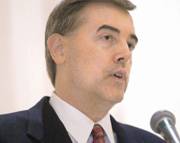
Jeremy Aguero, a principal analyst with Applied Analysis, remains optimistic about Las Vegas’ future, saying, “This economy has weathered storms before and I certainly believe it will weather this one.”
Sunday, April 5, 2009 | 2 a.m.

Keith Schwer

Alan Schlottmann, a UNLV economist, criticized report Aguero wrote for homebuilders, saying it downplayed danger of massive inventory build-up.

Paul Krugman, the Nobel Prize-winning economist and New York Times columnist, issued early warning about the housing bubble.
Sun Archives
- Vegas PBS offers 'Recession RX' (4-3-2009)
- Economic slowdown predicted through end of year (4-2-2009)
- Economy forces Centennial Hyundai to close its doors (4-1-2009)
- Real estate investment trusts report large losses (3-30-2009)
- Vegas visitor profile: Older, spending less (3-28-2009)
- Building, casino job losses fuel jobless rate (3-27-2009)
- Professionals pessimistic about speedy economic recovery (3-20-2009)
It’s April 2008.
Las Vegas is in the midst of a housing meltdown. Nevada’s foreclosure rate has led the nation for most of a year. Defaults and repossessions are on the rise. And home values are 30 percent off their high marks.
Enter Jeremy Aguero, a principal of the consulting firm Applied Analysis and the region’s most prominent economic forecaster. Delivering his annual report to the business community, Aguero acknowledges the bad news. His survey shows homeowners and entrepreneurs wondering when the market will hit bottom after 20 years of explosive growth.
Comfort, though, is found on the first page of the report, titled the Las Vegas Perspective. Aguero says the economy remains sound, due in large part to the unprecedented amount of investment under way on the Las Vegas Strip.
“The coming years will witness some of the most creative resort projects ever to enter the market, while infrastructure improvements will pave the way for longer-run expansions,” Aguero writes. “These factors will continue to spur one of the nation’s most resourceful and resilient economies forward.”
In the weeks after Aguero’s presentation, however, a series of unfortunate events blew through Las Vegas like a desert sandstorm.
Growth on the Strip screeched to a halt and turned backward: visitor volume fell, gaming and sales revenue declined, unemployment rose and the housing crisis deepened.
Aguero was not alone in missing the crash. Others in Nevada’s relatively small ranks of economic analysts saw conditions as much sunnier than they were, including leading UNLV economist Keith Schwer and gaming industry analysts.
Their opinions reassured businesses considering expansion and Nevadans considering major purchases. Go ahead. No need to hunker down.
Elected officials likewise moved forward. Even as airlines pleaded with the Clark County Commission to stop a planned airport expansion last summer, commissioners marched on, saying new resorts would create new demand.
Some saw it coming
So just how did economic forecasters miss so badly — and continue to miss even as late as last spring?
In many ways, the crash was predictable, especially for a town built on tourism and discretionary income. As early as 2006, a small group of national economists warned that a housing bubble had created trillions of dollars in illusory wealth — and that its bursting would set into motion a series of events that would topple the economy.
In 2006, New York Times columnist and Nobel Prize-winning economist Paul Krugman explained it like this: “Over the last few years, most good U.S. economic news has been the result of soaring home prices. Spending on new houses created jobs and poured cash into the economy. Consumers borrowed against the rising values of existing homes and went on a buying spree, spending more than they earned for the first time since the Great Depression.”
That fall, New York University economist Nouriel Roubini, who had been predicting a housing-led recession for months, not only declared the real-estate ride over, he said “it’s going to be a nasty fall.”
Some outside economists looked specifically at Nevada and saw major problems.
David Shulman, senior economist at the UCLA Forecast and a former analyst for Lehman Bros. who retired well before the company went bankrupt, co-wrote a report on the housing bubble for the firm’s clients in 2004. The report singled out Las Vegas for its soaring home prices.
The Las Vegas bubble had burst, he wrote.
In fact, the bubble appeared to continue for nearly two years, fed in part by local fervor and despite what Shulman saw as clear cautions. “Building houses for construction workers is inherently unstable,” Shulman said. “People should have known that.”
Also foreseeable long before the crash was a “dual credit bubble” Shulman said the region faced: consumers with subprime mortgages and casino companies with highly-leveraged projects.
“No one figured out how highly leveraged both sides were,” Shulman said. “The lesson for analysts and economists is to realize how important the credit channel is in distorting markets.”
At first, most experts, including the Federal Reserve, called those voices alarmist, predicting instead a “soft landing” for the economy. Those opinions slowly changed, however. Toward the end of 2007, it was clear the housing bubble had burst. Nationally, economists began falling into line.
But Nevada’s leading economic voices were slow to follow, as was true in other states.
Florida, whose economy also relies on growth, rode the real-estate boom until the bust as well. The behavior was driven in large part by the state’s history of adding 1,000-plus people a day for the past 30 years, with only a few exceptions, said Gary Mormino, a historian at the University of South Florida who has written a social history of the state.
Outside of an occasional newspaper article on a housing scam artist, Floridians didn’t hear much bad news, he said. “The doomsayers were not audible,” Mormino said.
Shulman, of the UCLA Forecast, said a psychology is at work among economic forecasters: “There’s a real reluctance to stop the party, especially when the market is telling you you’re wrong. That’s why the mortgage industry continued.”
If you foresee a downturn and “you’re right and early, you lose credibility,” Shulman said. “The vested interests want to keep the boom going. If you say no, you look dumb until the bust happens.”
The Strip was also caught up in the euphoria.
I. Nelson Rose, a gambling law expert who writes extensively about the gaming industry, said casino executives and their consultants showed a sort of “psychosis” in pursuing a series of ambitious expansion projects, especially at a time when the industry’s overall growth was slowing, due in part to tribal gaming.
UNLV economist Bill Robinson, who did see the downturn coming, said part of the problem in Nevada is that the more dour forecasters of the past turned out to be wrong. Those included forecasters who said years ago that Steve Wynn or Sheldon Adelson had taken on too much debt or built at the wrong time, only to see their companies enjoy wild success.
Still, Robinson said recent analysts should have taken into account the debt load taken on by MGM Mirage, which currently owes creditors $13 billion. “People should have seen it. I don’t understand why they took on the building projects and the debt they did. They should have known, they should have seen it, and they should have prepared.”
The analysts for Nevada’s main industry also struggled to see the deep flaws in the business strategy of gaming companies. As gaming stocks started to weaken, analysts seemed conflicted.
In January 2008, Bill Lerner of Deutsche Bank questioned whether Las Vegas would weather a downturn after gaming revenue showed weakness in November 2007. “It begs the question: Does the consumer see things differently than in the past?” Lerner told the Reno Gazette-Journal. “We are in a period of economic weakness in the United States as far as fuel cost, interest rates and housing. These numbers are pretty consistent with lousy numbers across the U.S.”
But that same month Lerner also pointed to the gaming sector’s past resilience and suggested the emerging weakness presented a buy opportunity for gaming stocks, predicting that Las Vegas Sands would soar to $120 a share, according to a story in USA Today. The stock rose to $89 before plummeting. It currently trades at $4.49, up from a low of $1.38.
In an interview Friday, Lerner acknowledged that his stock forecasts were off. He said he was blindsided by decisions by Sands and MGM Mirage to continue to fund development projects even when it was clear it was imprudent to do so, which negatively affected their balance sheets.
He also noted that he was correct in raising alarms about overbuilding in the Las Vegas market in particular.
Other gaming industry analysts were as optimistic as Lerner. “I don’t have a lot of worries about gaming” in 2008, said Jefferies & Co. analyst Lawrence Klatzkin. “It’s not going to be a record year, but it will be a solid year.”
In fact, then-MGM Mirage CEO Terri Lanni seemed to be alone in seeing a tough 2008. He said the company was concerned that the weak housing market and rising gas prices would slow corporate and personal travel to Las Vegas and slash spending here.
A small fraternity
Aside from gaming industry experts, Nevada has relatively few economic analysts. The two most prominent are Aguero, who has a degree from UNLV but is not an economist, and Schwer, an economist who runs UNLV’s Center for Business and Economic Research, publishing a monthly economic analysis as well as issuing an economic forecast twice a year.
Aguero is the best known. He’s done work for a blue-chip roster of clients, including the Nevada Development Authority and the Southern Nevada Homebuilders Association.
In late 2007, Aguero did a study for the Southern Nevada Homebuilders Association detailing the softening of the local economy, and the housing market specifically.
“There is little doubt that the Southern Nevada’s residential market is experiencing one of the worst downturns in the region’s history ...,” he wrote. He also noted “the region’s economy continues to report signs of weakening.” He noted consumers’ heavy debt loads and slackening consumer confidence.
But Aguero predicted a soft landing. “Based on historical business cycle trends, the timing of major resort project openings and a review of current conditions, we expect that the residential market will see evidence of a gradual recovery by late 2008.”
He continued: “Moreover, we believe that there is a very real potential that a housing shortage, and more specifically, a workforce housing shortage, will emerge by late 2009 or 2010.”
In interviews with the Las Vegas Sun for this story, Aguero defended his firm’s work and said the Sun is unfairly cherry-picking only those findings that turned out to be untrue. He also noted that almost no one predicted the swift and sharp downturn.
To his credit, Aguero began sounding the alarm on foreclosures in 2006 and said the rapid increase in hotel capacity would exert downward pressure on room rates.
“We try to analyze the market based on the best available information,” he said. “There are certainly things we’ve gotten right and certainly things we’ve gotten wrong.”
He said the recession was unforeseeable.
“Do we believe that when we did the (housing) report and modeled out employment, growth and expectations, that a housing shortage would come earlier rather than later? Yes,” Aguero said. “Did we foresee the type of global financial catastrophe in the last quarter of 2008? Surely, we did not.”
Throughout the winter of 2007-08, Schwer repeatedly referred to the $30 billion in Strip construction as the savior of the state’s economy. As late as April 2008, with the state reeling from the downturn and government facing a nearly $900 million deficit, Schwer continued to beat the drum. He pinned some hope on the 2008 federal economic stimulus plan.
“It is hard to see a big recession coming,” he said at the time. “We aren’t falling off the face of the earth.”
Other local analysts did see the storm gathering much sooner. Those included UNLV professors Robinson and Tom Carroll, as well as John Restrepo of Restrepo Consulting Group and vice chairman of the Nevada Economic Forum.
They had more sober assessments, which ran counter to the interests of the industries hoping to sustain the boom.
“I’ve been told I’m too negative,” Restrepo said in an interview Friday. “But what am I going to do? I gotta call the good, the bad and the ugly.”
Robinson and Carroll said they found the upbeat analysis by more prominent local forecasters a bit baffling.
Robinson acknowledged the difficulty of foretelling economic conditions, but said he was always a little surprised that optimistic assessments continued even as housing appreciation became obviously untenable.
“I sold my house in 2005, and people said to me, ‘Why are you selling?’ I told them, ‘Because if I don’t sell it now, I won’t be able to sell it until 2010.”
Carroll said Nevada has “a lot of self-styled experts. They find out what the client wants to hear, and then they produce it. It reinforces the groupthink that got us into this mess.”
Alan Schlottmann, a UNLV economist and executive director of the Theodore Roosevelt Institute, a research and consulting think tank, said through a spokesman the 2007 report Aguero wrote for the homebuilders was factually flawed because it miscalculated the enormous and rising inventory of unsold homes.
Forecast changes quickly
Although Schwer recognized the crash late, he turned quickly. Less than a week after giving his upbeat assessment last April, Schwer had new numbers in hand.
“We’re getting a clear signal that the economy is headed toward recession,” he said.
All 10 indicators in Schwer’s economic index trended negative, for the first time since it was established in 1990. Job growth slowed, unemployment rose and new home permits dropped nearly 70 percent. Population growth slowed, visitor volume slipped and gaming revenue fell.
In an interview, Schwer said that although he identified the risks of the housing bubble in 2005, he stuck rigidly to the technical definition of a recession as he watched the effects of the collapse. A recession usually is defined as a downturn in four key areas — employment, income, sales and industrial production — for two consecutive quarters. In Nevada, Schwer weights heavily gaming revenue, visitor volume, employment and sales.
Schwer said his forecasts relied on two sets of assumptions. One was that Strip construction would be completed. The other was that this downturn would go the way of the previous two recessions — the early 1990s and the one following the tech crash/Sept. 11 period, meaning business would bear the brunt of adjustments with little effect on consumer spending.
“You don’t want to make a call too early that it’s a recession,” he said.
The effect of the credit crunch wasn’t clear until spring 2008, he said. “We saw a lot of adjustments on the homebuilding and finance side,” Schwer said. “We had to wait to see clearly it was coming from the consumer side as well.”
He added: “It wasn’t a perfect storm. It was a series of train wrecks.”
“Will I make mistakes?” Schwer asked. “Sure. It’s not easy (to forecast). No one knows the future for sure. But it seems like we were honest about what we were able to see at the time.”
What lessons have local forecasters learned?
In his annual Las Vegas Perspective presentation last week, Aguero devoted half of his program to the torrent of bad news about the region’s economy, joking that a piece of sky had hit him on the head that morning.
Nearly every economic indicator was red, he said, including debt, unemployment, gaming revenue, jobs, population and home values.
But Aguero ended on an up note, highlighting the state’s business-friendly tax climate, its potential for solar energy and, yes, its weather.
From a historic context, he said the state was “well halfway” through the recession. “This economy has weathered storms before and I certainly believe it will weather this one,” Aguero said.
For his part, in an interview, Schwer summarized what he has learned.
“Yes, recessions come. No, Las Vegas is not recession-proof. And what happens nationally is really important.”
Sun reporter Alex Richards contributed to this story.

Join the Discussion:
Check this out for a full explanation of our conversion to the LiveFyre commenting system and instructions on how to sign up for an account.
Full comments policy